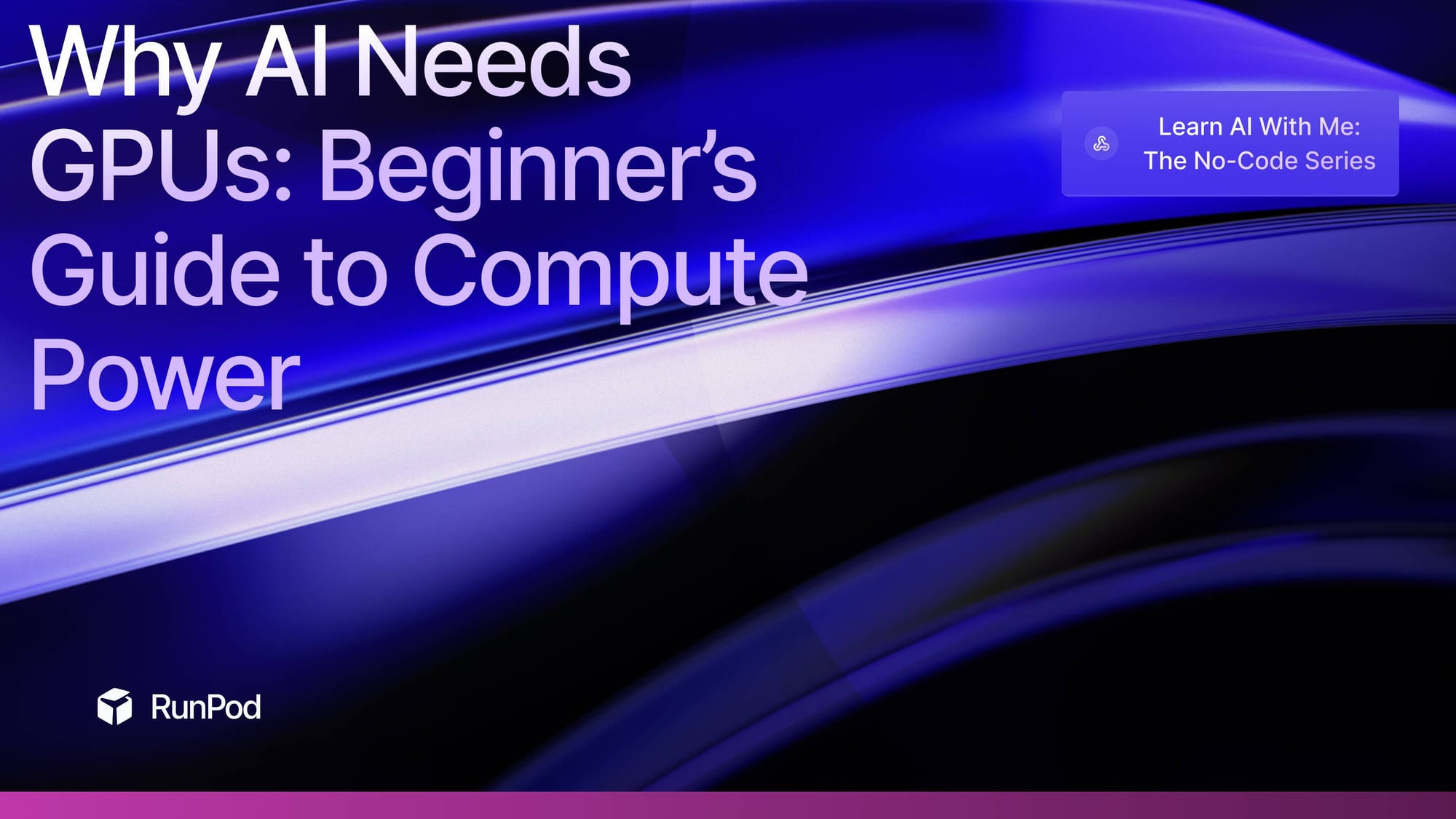Why AI Needs GPUs: A No-Code Beginner’s Guide to Compute Power
Why AI models need GPUs, how to choose the right one, and what makes cloud GPUs ideal for no-code AI experimentation. A beginner’s guide to compute power.

This is Part 4 of my "Learn AI With Me: No Code" Series. Read Part 3 here.
CPUs vs. GPUs (and Why It Matters for AI)
When I started learning about AI, one of the first things I kept hearing was "you need a GPU." Not just a decent laptop. Not just a beefy CPU. A GPU.
But why?
I was married to a gamer for 20 years, so everything I knew about GPUs was related to graphics and video rendering. Why does AI need them, even just for Large Language Models?
The short version: AI workloads involve massive amounts of parallel computation. GPUs (graphics processing units) are designed to run thousands of small calculations at the same time. That makes them perfect for graphics and video rendering, but also for the kinds of tasks AI models perform—especially matrix math and vector operations, which are the building blocks of machine learning.
In contrast, CPUs (central processing units) are optimized for sequential tasks—running your browser, managing your operating system, keeping your apps responsive. They're general-purpose workhorses, but not built for deep learning.
Why Machine Learning Is So GPU-Hungry
Training and running AI models means doing millions (or billions) of math operations in parallel. Every time a model makes a prediction, it’s multiplying vectors, applying weights, and adjusting parameters.
It’s not just about speed—it’s about scale. A simple model might be manageable on a CPU. A modern LLM with billions of parameters? You’ll be waiting days—if it runs at all.
That’s why GPUs became the default compute layer for AI. They're fast, efficient, and optimized for the kinds of math neural networks rely on.
What Makes One GPU Better Than Another?
When you deploy one of RunPod’s GPU-powered templates, you’ll see a mix of cards—3090, 4090, A100, H100, and so on. But what actually makes them different?
Here are a few factors that matter:
- VRAM (Video RAM): More VRAM means you can load larger models and batch more inputs. If you’re running out of memory, you’ll crash or throttle.
- Tensor cores: These are specialized processing units optimized for AI workloads (especially in NVIDIA GPUs).
- Throughput: Measured in TFLOPS (trillions of floating-point operations per second). More TFLOPS = more compute = faster training/inference.
- Architecture: Newer GPUs (like the H100) come with improved architectures that handle certain operations more efficiently, especially for large-scale LLMs.
✏️ Wait—What’s a “Template”?
On RunPod, a template is like a pre-configured starting point for running an AI model. It bundles up all the stuff you’d normally have to install or configure yourself—like the model, its frontend, dependencies, environment settings, and sometimes even the weights.
Instead of starting from scratch, you just pick a template (like “text-generation-webui” or “Stable Diffusion”), and RunPod sets it up on the GPU for you. You still get to choose the GPU and tweak settings, but the template gives you a huge head start—especially if you’re not sure what to install or how to get a model running.
TL;DR: It’s the difference between “open a blank notebook” and “open a ready-to-go workspace with everything installed and waiting.”
Cloud GPUs vs. Local Hardware
If you’ve got a gaming PC with an RTX 3090, that’s a solid place to start for learning. But training or running large models locally comes with limitations:
- You’re capped at one card (unless you build a multi-GPU rig)
- You’re paying for the electricity
- You can’t easily scale
That’s where cloud GPUs come in. On RunPod, you can spin up machines with exactly the GPU you need—for minutes, hours, or months. No up-front hardware costs. No infrastructure headaches. Just compute, on demand.
You can use Pods to launch and manage your own GPU environment—or skip setup entirely with Serverless endpoints (more on that below).
What About Serverless GPUs?
RunPod also offers Serverless GPU endpoints, where you don’t manage the infrastructure at all. You just send in a request (like an API call) and get a result back. It’s a great option for inference (running a model) when you don’t want to worry about pods, containers, or provisioning anything yourself.
✏️ Wait—What Even Is an Endpoint?
If you’re not familiar with developer terms, “endpoint” sounds like some ominous final destination. It’s not. An endpoint is just a place you send a request online—and get something back. With RunPod Serverless, you send input (like a prompt or image request), and the model runs in the background, returning your result. No setup, no pod, no terminal. Just results.
We'll go deeper on serverless in a future post—but just know it exists, and it can save you time (and money) depending on your workload.
TL;DR: Which GPU Should You Pick?
If you’re just starting out and running small models:
- ✅ RTX 3090 or 4090 – Affordable, powerful, and great for most entry-level LLMs or image generation.
If you’re scaling up:
- ⚡ A100 – Great for training or running larger models with high VRAM requirements
- 🚀 H100 – The latest and greatest for ultra-high-throughput workloads or massive model inference
When in doubt? Start with a 3090 or 4090. You can always scale up once you hit a limit.
Coming Up Next:
In Part 5 of this series, I’ll break down how loss functions work—and how AI models learn from their own mistakes.
Want to try this yourself? Explore RunPod’s template options here and launch a model in minutes—no code required.
Prefer to skip setup entirely? Serverless might be the move. We'll cover that soon.
